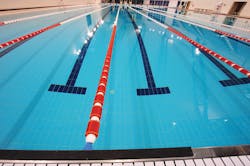Even in the best of times, it is difficult to operate a public swimming pool cost-effectively. But cash flow is particularly important for nonprofit recreation centers like the Geneva Lakes Family YMCA in Lake Geneva, Wis.
“We have done many equipment, lighting, heating and cooling upgrades to lower our energy costs,” said Joe Peyer, executive director of the Geneva Lakes Family YMCA. “That’s why we were interested in how variable-frequency drives (VFDs) for our main pool pump and air handlers could save us more energy.”
Peyer faced an energy double-whammy due to the high cost of operating a single-speed pump for a 180,000-gal, 25-meter competition pool and two single-speed motors for the facility’s air handlers.
“Ever since we opened, those air handlers created extreme negative pressure in the building,” Peyer said. “That caused many problems. It was tough to open the doors in the pool area, and then they would slam shut, which was dangerous. I had to put special closures on the door to make sure kids’ fingers didn’t get caught. The negative pressure also caused backdrafting that affected our gas heaters and main boiler. We had nonstop service calls to deal with power vent issues on our gas-fired burners and constant sooting in the boiler.”
Optimal Flow
Peyer looked to Tim Ruesch, regional sales manager for Innovative Cost Solutions, Green Bay, Wis., for answers.
“The YMCA was using single-speed drives for the pool pump and the air handlers. We knew that by incorporating the Danfoss VLT AQUA Drive we could save the facility a substantial amount of money,” Ruesch said.
The first problem Ruesch addressed was the energy being consumed by the pool’s always-on, constant-speed pump.
“The pump was consuming more than 15 kW around the clock,” Ruesch said. “But pumping full speed all the time wasn’t really necessary. Health requirements called for the total volume of pool water to turn over every six hours while the pool is in operation, which translated in this case to 500 gpm [gal per minute]. To get that flow rate, they were using a 15-hp pump. But my research showed that a VFD could deliver the required volume with less horsepower and much lower kilowatts.”
The drive used has a variable-frequency design with integrated controls developed especially for water applications. In this case, Ruesch was counting on the drive’s flow compensation algorithm to vary flow to meet the pool’s flow requirements and thus optimize energy consumption. When the pool is in heavy use or the filters need cleaning, the pump horsepower would be increased. During minimal usage or at night, the pump horsepower would be decreased.
Protective Coating
The drive also brought another benefit specific to swimming pool applications: Inside the drive housing, the printed circuit boards are specially coated to withstand the harsh affects of chlorine.
“I worked with Danfoss VLT units before,” Ruesch said. “Their compact design easily fits into tight installation spaces, which is great for a retrofit job like this one. Plus, the electronics are completely protected inside a rugged metal housing. The electronics are also separated from the cooling air flow to protect against dust and debris. It is a very robust and intelligent design.”
ROI
Taking advantage of the drive’s control capabilities, Ruesch wired the unit to a digital flowmeter. When pool usage and filters required higher pressure, the flow compensation algorithm accelerated pump speed. It reduced speed, however, when the pool was closed.
As a result of the flow compensation and drive efficiency, the YMCA saw some impressive electricity savings. “Compared to our original 15-kWh pump, the drive runs at 8 kWh when the pool is occupied and 2 kWh when we are closed,” Peyer said. “Those energy savings come to about $3,500 per year.”
After the success of the first drive, Ruesch was eager to tackle the negative air pressure problem.
“They had this monster air handling unit to eliminate the chlorine smell,” said Ruesch, who has been involved with commercial pool applications for 10 years.
“I calculated the cfm needed for sufficient air changes and found that once again a VFD was the answer.”
This time, Ruesch applied two Danfoss VLT HVAC drives—one rated for 15 hp, the other for 20 hp—built on a modular plug-and-play platform and dedicated to HVAC applications. The drives were easy to install. “In this case, no sensor wiring was necessary,” Ruesch said. “I just set the rpm for the fan to deliver the required cfm.”
“The instant [Ruesch] installed the two drives on the main air handler, we solved all of the negative air pressure issues, not to mention a reduction in white noise in the pool deck area,” Peyer said. “Since then, we have had no unplanned service calls.”
The energy savings also have been outstanding. One year after the air handler and pump drives were installed, they yielded a combined annual energy savings of $10,000. That does not take into account incentives from the utility that added up to more than $3,000.
“With returns on investment like that, this type of drive retrofit application easily sees a payback in 12 to 18 months,” Ruesch said. “That fact is opening doors for more work in other aquatic facilities. We have a lot of indoor water parks, competition pools and recreations centers around here because of the long winters. These facilities usually operate as public or nonprofit businesses, so they can’t afford the high operating costs of misapplied, single-speed drives on pumps and air handlers. VFDs are a very attractive energy-saving solution.”
As for Peyer, he is enthusiastic about the drives. “They have been nothing short of fantastic for our facility and for our cash flow,” he said.
Download: Here


